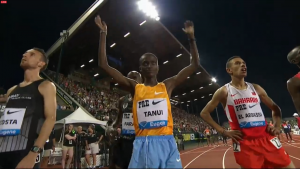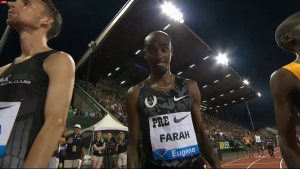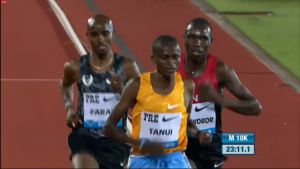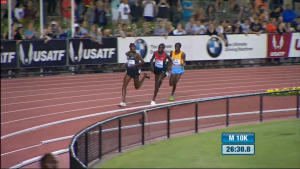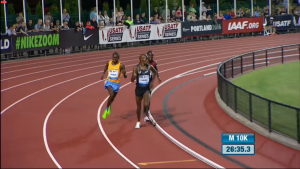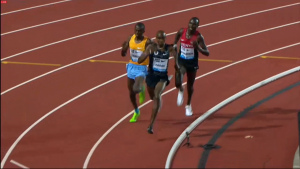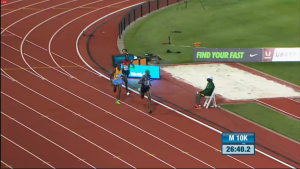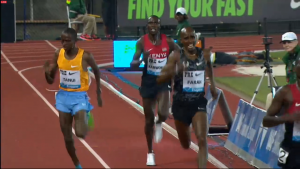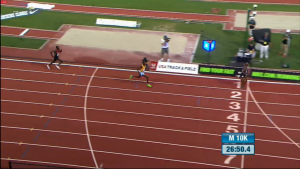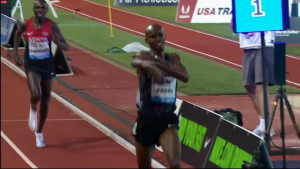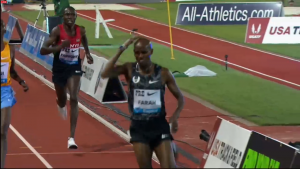Mo Farah Still Owns The 10,000m As He Takes Down Geoffrey Kamworor And Paul Tanui At Pre
by LetsRun.com
May 30, 2015
EUGENE, Ore. – Mo Farah still owns the 10,000.
For 25 laps on Friday at Hayward Field, the double Olympic champion endured all that Paul Tanui (2013 world 10,000 bronze medalist) and Geoffrey Kamworor (reigning world half and World XC champ) could throw at him. And for 9,900 meters, it looked like Farah was vulnerable, in danger of losing his first 10,000 since 2011. But in the final 100, after looking over his shoulder repeatedly during the final turn, the 32-year-old Brit was in a league of his own, leaving Tanui and Kamworor in the dust as he won a thrilling 10,000 at the 2015 Prefontaine Classic in 26:50.97, the world’s fastest time since his training partner Galen Rupp ran 26:44.36 here last year.
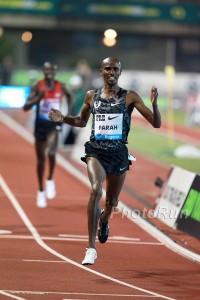 Mo Farah Still the King
Mo Farah Still the King
Four years ago in this race, Farah emerged onto the global scene with a surprising 26:46.57 victory. After that race, he went on to establish himself as the world’s greatest 5k/10k man with three World Championship and two Olympic gold medals. Farah’s win on Friday reaffirmed that status, as he defeated two of his most serious challengers for the 10,000 world title in Beijing later this summer, World XC champ Kamworor and 2013 World 10,000 bronze medalist Tanui.
Though the final 100 meters was vintage Mo, this was not your typical Farah race. Hoping to capitalize on his fitness with a time in the 26:30s, Farah frequently went to the lead, something he almost never does before the final three laps of a race. Ultimately, the lack of a quality rabbit (none of the three in this race made it more than 4k) and slightly warmer and windier than ideal conditions (temps in 60s with slight breeze) derailed any hopes of a truly fast time, which disappointed Farah as he crossed the line.
On reflection, Farah should have plenty to be happy about. He took the best punches from two of the world’s greatest 10,000 men and still had the energy to throw a knockout blow of his own. Running 26:50 won’t do much for Farah’s legacy, but leading a race mid-race will improve it slightly and winning the race was a major step toward defending his world title in Beijing.
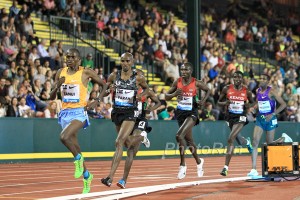 Paul Tanui Leads Farah and Kamworor
Paul Tanui Leads Farah and Kamworor
The Race
The very first thing that happened in this race is that Eritrea’s Nguse Amlosom got himself disqualified by cutting in from the barrel immediately. Though he ran much of the race (we didn’t see if he actually finished), Amlosom’s unfortunate mistake was evident and it was an easy decision for the officials to make.
Pace-wise, the race started quickly with A.J. Acosta leading a trio of rabbits through 400 meters in 61.5 seconds. Immediately, the big three of Farah, Tanui and Kamworor had moved to the front as they occupied the first three non-rabbit spots after one lap.
The first six laps passed without incident as the leaders hit 2400 in 6:21.5 (26:30 pace). At that point, it was looking like a fast time might be in the cards as Farah, Tanui and Kamworor all looked good. But the three rabbits, Acosta, Lee Emanuel and Alex Korio, had been reduced to just Korio and over the next few laps, he began to slow. 26:30 pace is 63.6 seconds per 400 and Korio led the pack through a 64.3 for lap 7 before running 64.7 and then a 65.4 to take them through 3600 in 9:35.9 (26:49 pace).
Sensing that the pace was lagging, Farah pulled level with Korio and later in that lap made a hand gesture toward Korio, imploring him to speed up. But the Kenyan was spent, and shortly after hitting 4000 in 10:40.6 (a 64.7 lap), Korio stepped off. If someone was going to end up with a fast time, they would have to do it the hard way.
Farah inherited the lead at that point but within 200 meters, Tanui had gone to the front and injected a surge of pace that reduced the lead pack from 10 to six. He could not sustain the pace though, and by the next lap they were back to running 64s and 65s as he and Farah traded pacing duties. Farah lead at the halfway mark at 13:21, which still projected for a fast time. But only one of those first five kilometers had been run without a rabbit, and the second half of the race would show just how difficult it is to run fast without someone pacing up front.
By 6,400 meters (17:08.6/26:47 pace), the lead pack was down to the three pre-race favorites, Tanui, Farah and Kamworor. Tanui and Farah continued to alternate leads for the next two kilometers; surprisingly Kamworor, who led almost all of the 12k race at World XC two months ago, remained in third, showing no intention to go to the front.
With a mile to go, the racing really began to heat up. The trio covered the 22nd lap in just 68 seconds and with a fast time slipping away from them, the priority shifted to winning the race. Farah seized the lead just past 8800 meters, running a 64 for lap #23 before Tanui passed him 100 meters into the penultimate lap. Farah really appeared to be straining as Tanui made the pass entering the backstretch, but Farah quickly composed himself and responded to the move before a gap could form. Kamworor continued to hang tough in third.
A 65-second penultimate lap took them to the bell at 25:54, Tanui still leading. With 350 to go, Farah made his bid, taking the lead.
This was it. Kamworor knew he needed to get by Tanui and fought hard to pass him on the backstretch, finally moving up to second with 250 to go. But Tanui wasn’t done either, launching into a big move on the final turn and retaking second place. He tried desperately to move up to Farah, but the Brit was fully aware of him, checking over his shoulder several times on the final bend. As they hit the homestretch, Farah began to accelerate rapidly and it was clear that the 3:28 1500 man had access to a gear Tanui and Kamworor simply don’t possess. It was no contest over the final 100 meters as Farah pulled away to win it in 26:50.97, with Tanui second in 26:51.86 and Kamworor third in 26:52.65. Farah closed in 2:32 for his last kilometer, with his last 400 in approximately 56.5 seconds.
Canadian Cam Levins, who was not in the initial lead group of 10, ran a very smart race and was rewarded with a fourth-place finish in 27:07.51, smashing Simon Bairu‘s 27:23.63 Canadian record. Americans Diego Estrada (9th, 27:30.53) and Hassan Mead (11th, 27:33.04) both grabbed the IAAF standard as well.
Results and quick takes below:
| Pl. | Athlete / Team | Cnt. | Birth | Result | Score | |
|---|---|---|---|---|---|---|
| 1. | Mo FARAH | GBR | 83 | 26:50.97 | 1241 | WL |
| 2. | Paul Kipngetich TANUI | KEN | 90 | 26:51.86 | 1239 | SB |
| 3. | Geoffrey KAMWOROR | KEN | 92 | 26:52.65 | 1238 | PB |
| 4. | Cameron LEVINS | CAN | 89 | 27:07.51 | 1214 | PB |
| 5. | Geoffrey KIRUI | KEN | 93 | 27:17.91 | 1198 | SB |
| 6. | Emmanuel Kipkemei BETT | KEN | 83 | 27:22.34 | 1191 | SB |
| 7. | El Hassan EL ABBASSI | BRN | 84 | 27:25.02 | 1186 | PB |
| 8. | Joshua CHEPTEGEI | UGA | 96 | 27:27.57 | 1182 | PB |
| 9. | Diego ESTRADA | USA | 89 | 27:30.53 | 1178 | PB |
| 10. | Titus Kipjumba MBISHEI | KEN | 90 | 27:31.48 | 1176 | SB |
| 11. | Hassan MEAD | USA | 89 | 27:33.04 | 1174 | PB |
| 12. | Timothy TOROITICH | UGA | 91 | 27:39.71 | 1163 | SB |
| 13. | Josphat Kipkoech BETT | KEN | 90 | 27:40.20 | 1163 | SB |
| 14. | Stephen MOKOKA | RSA | 85 | 27:43.73 | 1157 | SB |
| 15. | Arne GABIUS | GER | 81 | 27:43.93 | 1157 | PB |
| 16. | Suguru OSAKO | JPN | 91 | 27:45.24 | 1155 | SB |
| 17. | Othmane EL GOUMRI | MAR | 92 | 27:46.34 | 1153 | PB |
| 18. | Zane ROBERTSON | NZL | 89 | 27:46.82 | 1152 | PB |
| 19. | Vincent Kipsegechi YATOR | KEN | 89 | 27:56.95 | 1137 | PB |
| – | Brian SHRADER | USA | 91 | DNF | ||
| – | Goitom KIFLE | ERI | 93 | DNF | ||
| – | Teklemariam MEDHIN | ERI | 89 | DNF | ||
| – | Kenneth Kiprop KIPKEMOI | KEN | 84 | DNF | ||
| – | Nguse AMLOSOM | ERI | 86 | DQ | ||
| – | Andrew J. ACOSTA | USA | 88 | DNF | ||
| – | Lee EMANUEL | GBR | 85 | DNF | ||
| – | Alex KORIO | KEN | 90 | DNF |
Quick Take #1: Don’t be concerned about the time. This was a great run for Mo Farah.
Farah’s goal coming in was to run fast, as he was hoping for a rabbit to take him through 5k between 13:15-13:20, setting him up to run in the 26:30s. That obviously didn’t materialize, and Farah wasn’t pleased with his time as he didn’t celebrate much afterwards. But when Farah crossed the line, the importance of this win was written on his face.
Coming off his first loss on the track in almost two years, some believed Farah was vulnerable tonight, and it certainly looked that way at times as he had to dig deep in the last kilometer. But in the end, he did what he has done so many times in the past and kicked away from everybody in the final 100 meters.
In the process, he beat two total studs in Kamworor and Tanui, who won’t have the luxury of Farah helping with the pacing when they meet again in Beijing in August. Hagos Gebrhiwet‘s win in Doha showed that Farah can be had in a kick at 3,000 meters, but for the Kenyan 10,000-meter men, it is “back to the drawing board” for beating Farah, as Steve Cram and Tim Hutchings noted after the race.
A jovial Farah mingled with the media for 9 minutes after the race which is captured below. He talked about everything from the 1500m to the half-marathon, taking on all comers, and how Galen Rupp is his #1 10,000m rival. He said, “Galen is my biggest rival I think … Don’t doubt Galen, I think one day he’ll definitely be Olympic champion for sure … I’m a little bit older than him and a little bit more experienced and I think that goes a long way.”
He even called out LRC for hyping up everyone as the next great challenger to Farah and said he could beat Usain Bolt 500m and up.
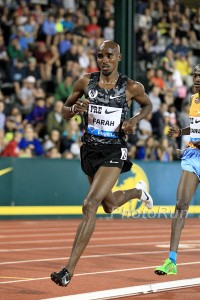 Farah and Tanui Had to Do Much of the Leading
Farah and Tanui Had to Do Much of the Leading
Quick Take #2: Kamworor has an excuse
Geoffrey Kamworor may have been only third here today, but he was pleased with his run and then indicated to LRC that his back was bothering him during the race. Beating Farah was a tough task, but the back injury excuse leaves a little intrigue for Worlds. Rivalries are good for the sport and a Kamworor-Farah rivalry would be great.
MB: Kamworor’s Got an Excuse: His Back Hurt
Quick Take #3: Even big $ couldn’t buy a good rabbit tonight
Even with one of its top runners itching to run a fast time in its showcase meet, Nike and the Pre Classic couldn’t secure someone capable of taking the field through halfway in 13:15-20, as Farah desired. It’s easy to blame organizers for getting a top rabbit, but in practice it’s a very tough job to get someone to rabbit a fast 10,000. The meet did a great job getting Stephen Sambu last year, who led for over 8,000 meters. Sambu was unavailable this year because he’s racing the UAE Healthy Kidney 10K in New York on Saturday, which offers $25,000 for the win (and a $30,000 bonus for breaking 27:35). No one is going to pay someone $55,000 to rabbit.
Farah’s agent Ricky Simms told LRC race organizer Tom Jordan went to great lengths to try and get a top notch rabbit. He said they offered some guys in the 5000m more than five figures to rabbit and they turned it down. There was even talk of getting Paul Tanui to rabbit. Simms said a final incentive was agreed upon for the race leaders to get a bonus for leading laps after 5,000m if the pace was still fast. None of it worked out in the end, as Tanui and Farah shifted their focus on winning versus helping the other run fast.
Only 40 guys in the world broke 13:15 last year. But to even-split a 13:15-20 from the front, you really need to be able to run sub-13:00. Only nine guys have done that in the last two years. Then when you consider not everyone who broke 13:00 is in that kind of shape right now and that their main priority is on their own season, not flying halfway across the world to rabbit a 10,000, it seems almost impossible to get a top-notch rabbit.
The best guy to pace this race might have been Galen Rupp, yet Rupp had his own race to deal with tonight. Bernard Lagat was very pleased with his run in the 5000m tonight, and he ran 13:14, which would have been a good pace for the 10,000m.
Quick Take #4: This was a great advertisement for the 10,000
World-class 10,000s are becoming exceedingly rare, and there has even been talk of dropping the event from the Olympic program. Tonight’s race showed why the 10,000 needs to stay. The time may not have lived up to the hype, but you can’t ask for much more from a race — three guys battling each other for 25 laps and a thrilling finish.
Quick Take #5: A race like this puts into perspective how great Kenenisa Bekele and Haile Gebrselassie were
Farah desperately wanted a fast time, and even though he tried to drive the pace over the second half, he still only managed to run 26:50. Bekele has broken 26:50 eight times in his career, Gebrselassie five. Most of those were from the front, with Bekele and Geb leading a lot of laps in the second half of the race.
Farah had good conditions and great competition and ran 26:50. Seven years ago at this meet, Bekele ran 26:25, basically alone (he won by 48 seconds) in the morning. It’s really hard to run fast from the front for such a long time. Instead of getting mad that Farah wasn’t able to do it on Friday, we should appreciate those that could.
Quick Take #6: USAs is more interesting now
Before the race, only three American men had the IAAF standard of 27:45, which could have led to an anticlimactic race if USAs went slow. Now there will be real drama as Diego Estrada and Hassan Mead join Rupp, Ben True and Shadrack Kipchirchir as Americans with the standard.
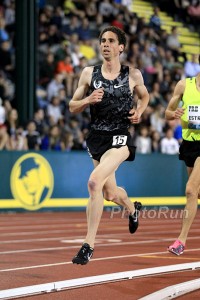 Cam Levins New Canadian Record Holder
Cam Levins New Canadian Record Holder
Quick Take #7: Congratulations, Cam Levins
Levins destroyed the Canadian record by 16 seconds, running a fantastic 27:07. He ran 13:33 in his final indoor race at Millrose and basically ran that back-to-back on Friday. Levins, who took bronze in the 10,000 at the Commonwealth Games last year, isn’t at the Farah-Tanui-Kamworor level, but he ran a very smart race on Friday and continues to improve every year.
Levins was gaining on the leaders form 4.5 to 5.5 miles in this race as he was all alone, running his own pace. It was very impressive to watch and afterwards, Levins was pleased to get the record. He said he knew coming in his fitness was good and he wanted to have the possibility of breaking 27 minutes if thinks went perfectly, but that will have to wait for another day.
MB: CAM LEVINS.. what can you say?
Quick Take #7: Tough luck for Suguru Osako, Othmane El Goumri and Zane Robertson
All three of those guys missed the IAAF standard by less than two seconds, with the Nike Oregon Project’s Osako coming just .24 from the standard. While all will still have a shot to make Worlds in the 5,000 (or taking another crack at the 10,000 before August 10), it’s got to hurt to come so close to the time and miss it.
Robertson’s time was a little surprising as he ran 3:34 for 1500 last year and 59:47 for the half marathon earlier this year.
Discuss this race on our fan forum:
- Mo Farah Calls Out LetsRun Hype Machine, Says Galen Rupp Will Be an Olympic Champ,
- Farah is a WIMP- refuses to push a 26:30 pace, runs 26:50
- CAM LEVINS.. what can you say?
- Kamworor’s Got an Excuse: His Back Hurt
Screenshots from the USATF.tv broadcast. Click for larger image.
- Tanui pre-race
- Farah pre-race
- The big-3
- Just over 100 to go
- Is Tanui going to take it?
- TIme to sprint
- Farah finds another gear
- Farah on his way
- Farah wins
- Farah celebrates
- Farah celebrates II







